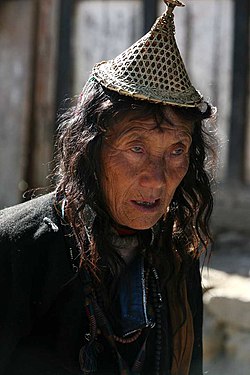Layap

Laya woman in Laya Gewog
|
|
| Total population | |
|---|---|
| 1,100 (2003) | |
| Regions with significant populations | |
| Bhutan (Gasa, Punakha, Thimphu Districts) | |
| Languages | |
| Layakha, Dzongkha | |
| Religion | |
| Buddhism, Bön (shamanism) | |
| Related ethnic groups | |
| Ngalops, Lhops, Tibetans |
The Layap (Dzongkha: ལ་ཡཔ་) are an indigenous people inhabiting the high mountains of northwest Bhutan in the village of Laya, in the Gasa District, at an altitude of 3,850 metres (12,630 ft), just below the Tsendagang peak.Their population in 2003 stood at 1,100. Ethnically related to the Tibetans, they speak Layakha, a Tibeto-Burman language. Layaps refer to their homeland as Be-yul – "the hidden land."
The dress of the Layap is similar to the Tibetan costume, except for a few differences. While men wear the Bhutanese costume, which consists of a silk or linen garment that is typically colored saffron and red (cf. gho). The women, on the other hand, wear black woolen jackets, which reach right down to the ankles. A blue pattern band may also be found at the bottom of their long sleeves. They also adorn themselves with silver jewelry and beads.
The most distinctive feature of the Layap women's dress is their conical hat. Made out of darkened bamboo strips, the conical hat ends with a sharp point to the sky, a cross similar to the Christian cross inverted to an upside down position.
Owing to Tibetan influence, the Layap practice a mixture of Bon and Tibetan Buddhism. According to legend, Laya village is the spot where Ngawang Namgyal, the founder of Bhutan, first entered the country.
Particularly unique among the Layap is the extensive tradition of "living defilements" (Dzongkha: soen drep), whereby a ritually impure person is ostracized from social activities. The Layap shun "living defilements" in order not to anger deities, and to avoid physical maladies and livestock plagues. Among ritually impure acts are birth, divorce, and death, including the death of a horse.
Located near the Tibetan border, the Layap have traditionally engaged in trade. Nowadays that includes the smuggling of bootleg Chinese blankets and plastic goods which are embargoed by the Bhutanese government, but in much demand by Bhutanese villagers.
...
Wikipedia
